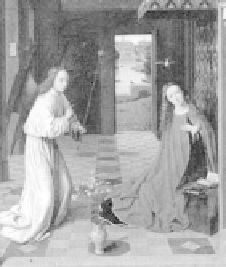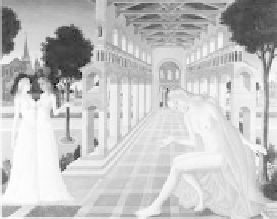Travel Reference
In-Depth Information
no Joke
An enthusiastic American teenager approaches the ticket
seller at the Groeninge Museum:
“This is the Torture Museum, right?!”
“No,” the ticket man replies, “it's art.”
“Oh...” mumbles the kid, “art....”
And he walks away, not realizing that, for him, the
Groeninge Museum would be torture.
with their window-on-the-world, 3-D realism. Petrus Christus,
one of Jan van Eyck's students, studied the Italian style and set out
to conquer space.
The focus of his
Annunciation
panel is not the winged angel
announcing Jesus' coming birth, nor is
it the swooning, astonished Mary—it's
the empty space between them. Your
eye focuses back across the f loor tiles
and through the open doorway to gabled
houses on a quiet canal in the far distance.
In the
Nativity
panel, the three
angels hovering overhead really should be
bigger, and the porch over the group looks
a little rickety. Compared to the work of
Florence's Renaissance painters, this is
quite...primitive.
• Fast-forward a few centuries (through Rooms 5-8), past paintings by
no-name artists from Bruges' years of decline, to a couple of Belgium's
20th-century masters in Room 9...
Paul Delvaux (1897-1994)—
Serenity
(1970)
Perhaps there's some vague
connection between Van
Eyck 's medieval symbols and
the Surrealist images of Paul
Delvaux. Regardless, Delvaux
gained fame for his nudes
sleepwalking through moon-
lit, video-game landscapes.
rené magritte (1898-
1967)—
The Assault
(c. 1932)
Magritte had his own private reserve of symbolic images. The
cloudy sky, female torso, windows, and horsebell (the ball with the
slit) appear in other works as well. They're arranged here side by side




















